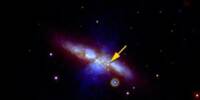Astronomers studying VLA Sky Survey (VLASS) data discovered one of the youngest known neutron stars, a superdense remnant of a massive star that exploded as a supernova. Images from the Karl G. Jansky Very Large Array (VLA) of the National Science Foundation show that bright radio emission powered by the spinning pulsar’s magnetic field has only recently emerged from behind a dense shell of debris from the supernova explosion.
The object, known as VT 1137-0337, is located in a dwarf galaxy 395 million light-years away from Earth. It first appeared in a VLASS image from January of this year. It was not visible in a 1998 image of the same region created by the VLA’s FIRST Survey. It continued to appear in later VLASS observations in 2018, 2019, 2020, and 2022.
“We’re probably looking at a pulsar wind nebula,” said Dillon Dong, a Caltech graduate student who will begin a Jansky Postdoctoral Fellowship at the National Radio Astronomy Observatory (NRAO) later this year. When the powerful magnetic field of a rapidly spinning neutron star accelerates surrounding charged particles to nearly the speed of light, a pulsar wind nebula forms.
“Based on its characteristics, this is a very young pulsar — possibly as young as 14 years, but no older than 60 to 80 years,” said Gregg Hallinan, Dong’s Caltech Ph.D advisor. The researchers presented their findings at the annual meeting of the American Astronomical Society in Pasadena, California.
Our discovery of a very similar source turning on suggests that the radio sources associated with FRBs may also be luminous pulsar wind nebulae. When the powerful magnetic field of a rapidly spinning neutron star accelerates surrounding charged particles to nearly the speed of light, a pulsar wind nebula forms.
Dillon Dong
Dong and Hallinan discovered the object in VLASS data, an NRAO project that began in 2017 to survey the entire sky visible from the VLA – roughly 80% of the sky. VLASS is scanning the sky three times over the course of seven years, with one of the goals being to detect transient objects. The astronomers discovered VT 1137-0337 in the first VLASS scan from 2018.
When that VLASS scan was compared to data from an earlier VLA sky survey called FIRST, it revealed 20 particularly luminous transient objects that could be associated with known galaxies.
“This one stood out because its galaxy is experiencing a burst of star formation, and also because of the characteristics of its radio emission,” Dong said. The galaxy, called SDSS J113706.18-033737.1, is a dwarf galaxy containing about 100 million times the mass of the Sun.
The astronomers considered several possible explanations for VT 1137-0337’s characteristics, including a supernova, gamma ray burst, or tidal disruption event in which a star is shredded by a supermassive black hole. They came to the conclusion that the best explanation is a pulsar wind nebula.
A star many times the mass of the Sun exploded as a supernova, leaving behind a neutron star. The majority of the original star’s mass was blown outward as a debris shell. The neutron star spins quickly, and as its powerful magnetic field sweeps through space, it accelerates charged particles, resulting in strong radio emission.

Initially, the radio emission was blocked from view by the shell of explosion debris. As that shell expanded, it became progressively less dense until eventually the radio waves from the pulsar wind nebula could pass through. “This happened between the FIRST observation in 1998 and the VLASS observation in 2018,” Hallinan said.
The Crab Nebula in the constellation Taurus is probably the most famous example of a pulsar wind nebula, the result of a supernova that shone brightly in 1054. Small telescopes can now clearly see the Crab.
“The object we discovered appears to be approximately 10,000 times more energetic than the Crab, with a stronger magnetic field,” Dong said. “It’s very likely an emerging’super Crab,'” he added.
While Dong and Hallinan believe VT 1137-0337 is most likely a pulsar wind nebula, it is also possible that the neutron star’s magnetic field is strong enough for it to qualify as a magnetar, a type of super-magnetic object. Magnetars are a leading candidate for the origin of the mysterious Fast Radio Bursts (FRBs), which are currently being investigated.
“In that case, this would be the first magnetar captured in the act of appearing, which is also extremely exciting,” Dong said. Some Fast Radio Bursts have been discovered to be associated with persistent radio sources, the nature of which is also unknown. They have properties that are very similar to VT 1137-0337, but no evidence of high variability has been found.
“Our discovery of a very similar source turning on suggests that the radio sources associated with FRBs may also be luminous pulsar wind nebulae,” Dong explained.
The astronomers intend to conduct additional observations in order to learn more about the object and to track its behavior over time. The National Radio Astronomy Observatory is a National Science Foundation facility run by Associated Universities, Inc. under a cooperative agreement.
















